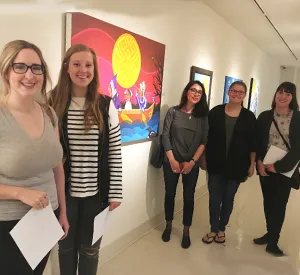
An art gallery may be an unusual setting for a social work class, but a group of St. Thomas students recently discovered that studying art can strengthen their social work practice.
Students in Dr. Raluca Bejan’s class, “The Profession of Social Work in Context,” visited the Beaverbrook Art Gallery to explore how ideas about race, gender, and Indigeneity in the works of art were used to depict vulnerable people in society.
“Oftentimes we imagine social work in terms of competency work and contained within specific domains: child welfare; hospital/medical interdisciplinary teams, etc. But social work is also about destabilizing ideological discourses in society,” explained Bejan.
The purpose of the visit was to examine time-specific and space-specific representation imagery. The students were asked to reflect on how certain ideas found in the paintings were contributing to stereotypes about groups of people with whom social workers engage regularly.
“It was such a great experience to view art from a social work perspective,” said student Jessica Arbing. “We were able to examine things relevant to our practice such as gender, race, Indigeneity, and social class. Art often reflects social values and reflects the socio-political climate in which they were painted. Even if this was not the intention of the artist, social issues are so present within art.”
The experiential learning aspect of the gallery visit made Brooke Johnston appreciate the artwork in a more personal way.
“Going into the art gallery and viewing the paintings gives them a much more powerful presence,” Johnston said. “Artwork doesn’t have the same impact when viewed in a textbook or on a smart board. In these formats, it’s easy to take the artwork for granted and not be able to see or appreciate the work put into the painting.”
During the visit, the students were given the chance to explore artwork that interested them. They were also guided through the gallery by an expert who gave them more background on the art and the artists, as well as context of what was happening in history when the art was created.
“Experiential learning facilitates students with a more diverse way of knowing. Not only does it get students excited to be out of the classroom, but it allows us to interact with our community, which as a social work student is something that I hold in great value,” Jessica Arbing said.
“It is also a tangible way to apply theory and class discussion into "real life." For example, within the social work program, we talk a great deal about representation. While as students we may understand what representation means in theory, but being in the art gallery gave us an opportunity to see representation within the art.”
/filters:format(webp)/prod01/stuca/media/stu/site-assets/images/features/Internship-Lauren-Feature.jpg)
/filters:format(webp)/prod01/stuca/media/stu/site-assets/images/features/map_system_news.jpg)
/filters:format(webp)/prod01/stuca/media/stu/site-assets/images/features/Kate-Hache-Sweden-feature.jpg)